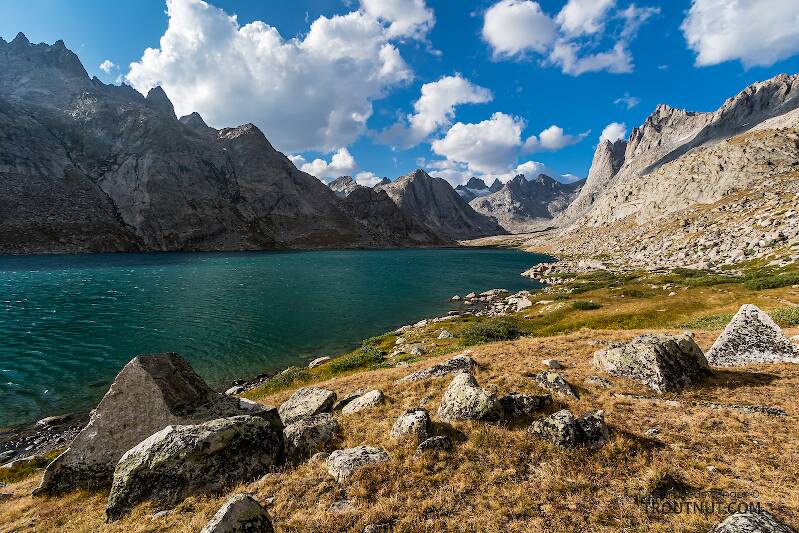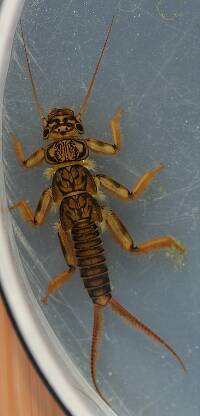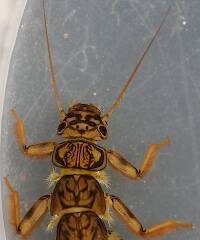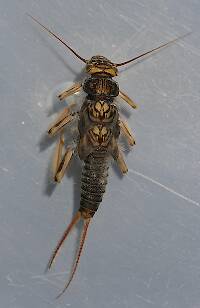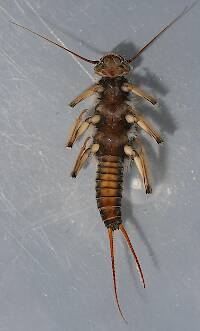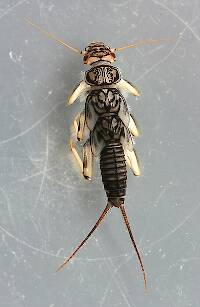
Blue-winged Olives
Baetis
Tiny Baetis mayflies are perhaps the most commonly encountered and imitated by anglers on all American trout streams due to their great abundance, widespread distribution, and trout-friendly emergence habits.
Featured on the forum

Nymphs of this species were fairly common in late-winter kick net samples from the upper Yakima River. Although I could not find a key to species of Zapada nymphs, a revision of the Nemouridae family by Baumann (1975) includes the following helpful sentence: "2 cervical gills on each side of midline, 1 arising inside and 1 outside of lateral cervical sclerites, usually single and elongate, sometimes constricted but with 3 or 4 branches arising beyond gill base in Zapada cinctipes." This specimen clearly has the branches and is within the range of that species.

Troutnut is a project started in 2003 by salmonid ecologist Jason "Troutnut" Neuswanger to help anglers and
fly tyers unabashedly embrace the entomological side of the sport. Learn more about Troutnut or
support the project for an enhanced experience here.
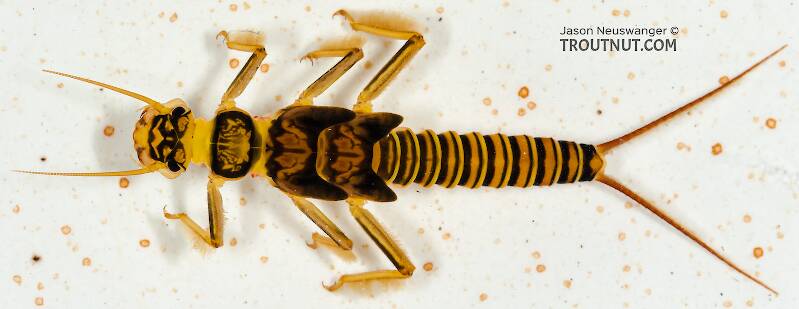
This large Perlodidae stonefly was a strikingly bright yellow color, more so than any other insect I've seen. I didn't enhance it much. See the discussion threads to follow how we identified this specimen, which was listed incorrectly for several years.
Troutnut on Jul 7, 2006July 7th, 2006, 3:46 am EDT
This stonefly comes from a fertile, cold small stream in the Catskills. I tried to ID it using the key to genera in Merritt & Cummins but I ended up with a fairly confident identification that can't be correct: Arcynopteryx, a western mountain genus. So I'm stuck at couplet 89 in the M&C key.
Jason Neuswanger, Ph.D.
Troutnut and salmonid ecologist
Troutnut and salmonid ecologist
Taxon on Jul 10, 2006July 10th, 2006, 3:16 pm EDT
Jason-
Guess I posted this response in the wrong place, as it didn't show up here. I realize you've already acknowledged the information somewhere else, but I'm re-posting it here for others to see.
Not to despair; this is what American Stoneflies: A Photographic Guide to the Plecoptera by Bill P. Stark, Stanley W. Szezytko, and C. Ridley Nelson has to say about genus Arcynopteryx:
"This genus is represented in North America by A. compacta (McLachlan). This species ranges from Alaska to Maine and has been reported as far south as Colorado. Males usually have shortened wings and are easily recognized by the long, lash-like epiproct tip. Females and nymphs are quite similar to Skwala. A. compacta has been collected around alpine lakes in the northern Rocky Mountains. No photographs are available for this group."
Also, Arcynopteryx compacta is listed by Stark/Baumann as residing in New York.
Guess I posted this response in the wrong place, as it didn't show up here. I realize you've already acknowledged the information somewhere else, but I'm re-posting it here for others to see.
Not to despair; this is what American Stoneflies: A Photographic Guide to the Plecoptera by Bill P. Stark, Stanley W. Szezytko, and C. Ridley Nelson has to say about genus Arcynopteryx:
"This genus is represented in North America by A. compacta (McLachlan). This species ranges from Alaska to Maine and has been reported as far south as Colorado. Males usually have shortened wings and are easily recognized by the long, lash-like epiproct tip. Females and nymphs are quite similar to Skwala. A. compacta has been collected around alpine lakes in the northern Rocky Mountains. No photographs are available for this group."
Also, Arcynopteryx compacta is listed by Stark/Baumann as residing in New York.
Dsc1
Posts: 2
Posts: 2
Dsc1 on Oct 14, 2008October 14th, 2008, 9:49 am EDT
Jason:
Not Arcynopteryx - they look quite different. It DOES look like Cultus verticalis, but you would have to have gone a different direction in interpreting the mesosternal sulci to get to Cultus. Found occasionally in cold, northern streams in New Hampshire (Arcynopteryx here also, but only one specimen so far). Another species or two of Cultus could possibly be candidates, but larvae in this group are not characterized for the species, with verticalis being the best candidate based on distribution.
Not Arcynopteryx - they look quite different. It DOES look like Cultus verticalis, but you would have to have gone a different direction in interpreting the mesosternal sulci to get to Cultus. Found occasionally in cold, northern streams in New Hampshire (Arcynopteryx here also, but only one specimen so far). Another species or two of Cultus could possibly be candidates, but larvae in this group are not characterized for the species, with verticalis being the best candidate based on distribution.
Troutnut on Oct 14, 2008October 14th, 2008, 3:00 pm EDT
Thanks for the reply! Always good to hear from someone who really knows some of these bugs.
Jason Neuswanger, Ph.D.
Troutnut and salmonid ecologist
Troutnut and salmonid ecologist
Sheinz
Posts: 3
Posts: 3
Sheinz on Feb 10, 2009February 10th, 2009, 4:40 am EST
For Troutnut:
Is the color true on the pictures?
These bugs look similar in shape to what I've found on branches and rocks all over Maine, but the photos you have posted look much yellower, and I've yet to see one 2.5 inches long. Based on other photos, it seems like the colors tend to be lighter than you'd observe stream side, I assume due to the artificial light you need to use to get decent depth of field and sharpness.
Most of the stone fly nymphs up here are more cream colored underneath with a darker back and might go 2 inches.
I'm trying to improve the version I tie. Are these pictures likely the same bug?
Is the color true on the pictures?
These bugs look similar in shape to what I've found on branches and rocks all over Maine, but the photos you have posted look much yellower, and I've yet to see one 2.5 inches long. Based on other photos, it seems like the colors tend to be lighter than you'd observe stream side, I assume due to the artificial light you need to use to get decent depth of field and sharpness.
Most of the stone fly nymphs up here are more cream colored underneath with a darker back and might go 2 inches.
I'm trying to improve the version I tie. Are these pictures likely the same bug?
Troutnut on Feb 10, 2009February 10th, 2009, 2:28 pm EST
Sheinz,
Your bugs are probably different species of stonefly in the same family, Perlodidae. This specimen really was strikingly yellow. The bright light helps, but this one would certainly stand out in a bucket anyway.
Your bugs are probably different species of stonefly in the same family, Perlodidae. This specimen really was strikingly yellow. The bright light helps, but this one would certainly stand out in a bucket anyway.
Jason Neuswanger, Ph.D.
Troutnut and salmonid ecologist
Troutnut and salmonid ecologist
Sheinz
Posts: 3
Posts: 3
Sheinz on Feb 12, 2009February 12th, 2009, 3:56 am EST
Dear Mr. Nut,
Thanks for the response.
Based on your reply, then would I be well advised try to imitate his shape and tie away? I'm liking moose mane for tails, tan antron yarn for the body, brown swiss straw (raffia) for the wing case, and plastic key chain eyes.
What do you like for legs?
Thanks for the response.
Based on your reply, then would I be well advised try to imitate his shape and tie away? I'm liking moose mane for tails, tan antron yarn for the body, brown swiss straw (raffia) for the wing case, and plastic key chain eyes.
What do you like for legs?
Sheinz
Posts: 3
Posts: 3
Sheinz on Feb 12, 2009February 12th, 2009, 4:31 am EST
If I can build on my last post, after looking around some more on your site - isn't what I've been seeing more likely to be a Perlidae?
Troutnut on Feb 12, 2009February 12th, 2009, 7:13 am EST
Now that I re-read your description, that does seem more likely. Only you know what you saw... just find the Perlid or Perlodid that looks the most like it here, and tie from that. :)
Jason Neuswanger, Ph.D.
Troutnut and salmonid ecologist
Troutnut and salmonid ecologist
Quick Reply
Related Discussions
Topic
Replies
Last Reply
6
Jul 28, 2012
by Entoman
by Entoman
Re: Which aquatic insects are most vulnerable to pollution???
In the Identify This! Board by Byhaugh
In the Identify This! Board by Byhaugh
4
Aug 14, 2014
by Lastchance
by Lastchance
1
Jan 29, 2016
by Martinlf
by Martinlf

